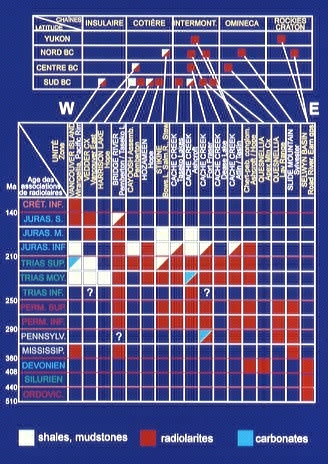

Radiolarian investigations
linked to geological mapping in the Canadian Cordillera has led to generate
an important database with extended geographic and chronologic ranges (see figure below).
The Canadian Cordillera is a landmark collage orogen where has been defined, in part, the concept of "terranes" (Coney et al. 1980). The oceanic terranes accreted to the North American margin contain large quantities
of radiolarian-bearing rocks (cherts) associated with ophiolites or paleo-accretion complexes, for instance the Cache Creek terrane which crops out
over 1500 km from southern British Columbia to the Yukon
(see map). The biochronological results obtained on these rocks reveal the occurrence of west-younging ages of ancient oceanic plates in relation with progressive amalgamation / docking of terranes
along the North-American margin during the Phanerozoic, illustrating on a broader scale the process
of continental accretion.
Another unit of the Canadian Cordillera called the Bridge River-Hozomeen terrane (map) contains radiolarian chert ranging in age from the Early Carboniferous to
the Middle/Late Jurassic, representing a time span of nearly 200 million years for oceanic sedimentation and ophiolitic rocks. It is one of the longest
accumulation of radiolarian chert known in the world, providing evidence for
the long lifespan of proto-Pacific ocean basins, and therefore of potentially
immense areas of oceanic crust that must have disappeared by subduction beneath
the North American continent in Paleozoic and Mesozoic times (Cordey 2025 and references https://doi.org/10.1130/b38286.1).

